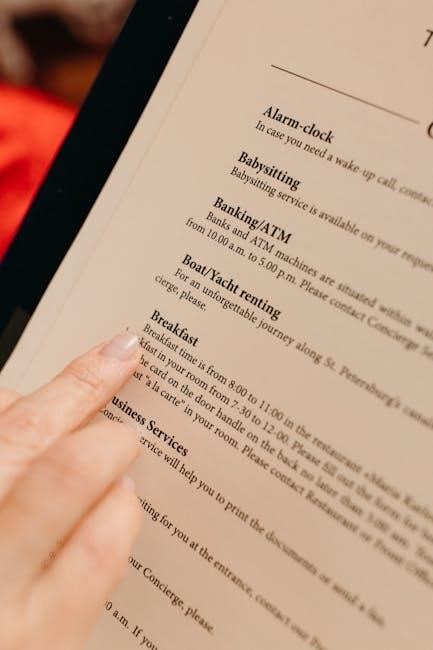The Academic Word List (AWL) is a curated collection of 570 high-frequency word families essential for academic success, widely recognized as vital for scholarly communication.

What is the Academic Word List (AWL)?
The Academic Word List (AWL) is a carefully curated collection of 570 word families that frequently appear in academic texts across various disciplines. Developed from a corpus of over 3.4 million words, the AWL represents the most commonly used vocabulary in academic writing and reading. It is designed to help non-native English speakers and students grasp the essential language needed for academic success. The list is widely recognized for its systematic approach, making it a valuable resource for learners preparing for standardized tests like IELTS and TOEFL. Each word family includes a base word and its derivatives, ensuring comprehensive vocabulary acquisition.
Importance of the AWL in Academic and Professional Settings
The Academic Word List (AWL) plays a pivotal role in enhancing academic and professional communication. It equips learners with high-frequency vocabulary essential for understanding complex texts and producing precise writing. The AWL is particularly valuable for non-native English speakers, as it bridges the gap between general and academic language. By mastering these word families, individuals gain a competitive edge in standardized tests like IELTS and TOEFL, while also improving their ability to engage with academic materials across disciplines such as arts, commerce, and science. Its relevance extends beyond education, supporting professionals in effectively conveying ideas in English-speaking work environments.
Overview of the AWL List PDF
The AWL List PDF is a comprehensive resource containing 570 word families essential for academic and professional settings. It is divided into sections, each focusing on specific ranges of words, such as the eighth installment covering words 421–480. The PDF includes definitions, example sentences, and usage contexts to aid learning. Additional resources like the IELTS Academic Word List and TOEFL Vocabulary Guide are also available, providing targeted preparation for standardized tests. These PDFs are designed to help learners systematically acquire vocabulary, with metadata such as file sizes (e.g;, 988 KB) indicating their detailed content. The AWL List PDF serves as a foundational tool for mastering academic English, offering a structured approach to vocabulary development.

Structure and Content of the AWL
The AWL contains 570 word families, organized into multiple sections like the eighth installment (words 421–480). Each section includes definitions, examples, and usage contexts, aiding learners in systematic vocabulary acquisition.
Breakdown of Word Families in the AWL
The AWL is organized into 570 word families, each representing a base word and its derivatives. These families are divided into sections, such as the eighth installment, which covers words 421–480. Each word family includes the base form, its inflections, and related words, ensuring comprehensive understanding. For example, the word “analyze” includes “analysis” and “analytical.” This structure helps learners grasp the full range of vocabulary in academic contexts, making it easier to recognize and use these words in various disciplines like arts, commerce, and science. The breakdown ensures systematic learning, with clear definitions and examples provided for each word family, facilitating effective vocabulary acquisition and application in academic writing and reading. This organization is a key feature of the AWL, making it a valuable resource for students and professionals alike.
Categories of Words in the AWL
The AWL is categorized into word families and sublists, ensuring a structured approach to vocabulary learning. Words are grouped by their frequency, relevance, and utility across academic disciplines. The list includes general academic words, such as “analyze” and “evaluate,” which are essential for understanding and producing scholarly content. Additionally, it covers discipline-specific terminology applicable to fields like science, humanities, and commerce. The AWL also incorporates common academic verbs, nouns, and adjectives frequently encountered in research papers and textbooks. These categories help learners focus on high-impact vocabulary, making it easier to grasp complex texts and communicate effectively in academic settings. This systematic categorization ensures the AWL remains a practical tool for academic success.
Frequency and Distribution of AWL Words Across Disciplines
The AWL words are distributed across various academic disciplines, with varying frequencies. While some words are universally applicable, others are more common in specific fields like science, engineering, or humanities. For instance, terms like “hypothesis” and “methodology” are frequently used in scientific contexts, whereas “narrative” and “interpretation” are more prevalent in arts and social sciences. This distribution reflects the diverse linguistic demands of different subjects. The AWL list PDF highlights these variations, ensuring learners are exposed to discipline-specific vocabulary. Understanding this distribution helps students prioritize their learning based on their academic focus, making the AWL a versatile tool for tailored vocabulary development. This tailored approach enhances both general and field-specific comprehension.

Benefits of Using the AWL List PDF
Using the AWL list PDF enhances vocabulary, improves test performance, facilitates text understanding, and supports academic communication, making it indispensable for learners seeking success in English academic settings.
Enhancing Vocabulary for Academic Success
The AWL list PDF is a valuable resource for expanding vocabulary, focusing on words essential for academic environments. It provides learners with a structured approach to mastering high-frequency academic terms. By studying the AWL, students can bridge the gap between general English and the specialized language used in academic texts. This enhances their ability to comprehend complex material and express ideas more effectively. The list includes 570 word families, offering a comprehensive foundation for academic communication. Regular use of the AWL list PDF helps learners develop a stronger lexical base, which is critical for success in academic writing, reading, and discussions.
Improving Performance in Standardized Tests (IELTS, TOEFL)
Mastery of the AWL list PDF significantly enhances performance in standardized tests like IELTS and TOEFL. These exams often include academic vocabulary that aligns with the AWL, making familiarity with these words crucial for success. The list helps candidates comprehend complex reading passages, identify key ideas, and decode unfamiliar terms. In writing and speaking sections, using AWL words accurately demonstrates a higher level of English proficiency. Additionally, the AWL reduces time spent on decoding unknown words, allowing test-takers to focus on answering questions more effectively. Regular practice with the AWL list PDF ensures better scores and greater confidence in these high-stakes exams.
Facilitating Understanding of Academic Texts
The AWL list PDF is an essential tool for understanding academic texts. It contains high-frequency words commonly found in academic materials. By mastering these words, learners can recognize and comprehend academic vocabulary more effectively. This reduces the need to look up unknown words, allowing for smoother reading. The AWL list PDF also provides context and usage examples, helping learners understand how words are applied in different academic contexts. This enhances reading efficiency and overall academic performance. Focusing on these high-frequency words prepares learners to tackle various academic texts across different disciplines. Regular study of the AWL list PDF improves comprehension of complex texts and leads to better learning outcomes. It is a valuable resource for anyone aiming to enhance their academic English skills, bridging the gap between general English and specialized academic vocabulary.
Supporting Effective Communication in Academic Settings
The AWL list PDF plays a crucial role in fostering effective communication in academic environments. By mastering high-frequency academic words, learners can express their ideas with greater precision and clarity. This enhances their ability to engage in meaningful discussions, participate in seminars, and present their work confidently. The AWL list PDF also aids in understanding complex lectures, academic papers, and conversations, ensuring learners can actively contribute to intellectual exchanges. It bridges the gap between general English and specialized academic language, enabling learners to articulate their thoughts effectively. This proficiency in academic vocabulary not only improves communication skills but also fosters collaboration and mutual understanding among peers and instructors, creating a more dynamic and productive academic community.

Challenges in Learning and Implementing the AWL
Mastery of the AWL list PDF presents challenges, including memorizing 570 word families and applying them contextually. Learners often struggle with rote memorization, leading to passive knowledge rather than active use, while integrating AWL vocabulary into daily communication remains a significant hurdle for many students.
Overcoming the Difficulty of Memorizing 570 Word Families
Memorizing 570 word families from the AWL list PDF can be daunting, but effective strategies exist. Use spaced repetition systems (SRS) like flashcards to review words at increasing intervals, enhancing retention. Focus on understanding meanings, synonyms, and contexts rather than rote memorization. Group words by themes or prefixes/suffixes to create mental associations. Practice active recall by testing yourself regularly. Incorporate vocabulary into sentences or short paragraphs to build practical usage. Utilize mnemonic devices or visual aids to make learning engaging. Prioritize high-frequency words first to maximize impact. Consistency is key—dedicate time daily to review and reinforce learning. Over time, these methods help transform memorization into long-term mastery.
Integrating AWL Vocabulary into Everyday Use
Integrating AWL vocabulary into daily life enhances language proficiency and reinforces learning. Start by using AWL words in personal journals or notes, applying them in meaningful contexts. Engage in conversations with peers or language partners, focusing on incorporating new terms naturally. Flashcards with example sentences can serve as reminders to use words in daily interactions. Set daily goals to learn and use a specific number of AWL words in writing or speaking. Participate in online forums or discussion groups where academic topics are explored, providing opportunities to apply AWL vocabulary. Regular practice ensures these words become a natural part of your communication, boosting confidence and fluency in academic and professional settings.
Addressing the Lack of Context in Word Lists
The AWL List PDF primarily provides words without context, which can make memorization challenging. To address this, learners can supplement their study with activities that embed words in meaningful scenarios. Reading academic texts, such as journal articles or essays, helps encounter AWL words in context. Additionally, engaging in discussions or writing exercises using AWL vocabulary fosters practical application. Flashcards with example sentences or definitions can also bridge the gap, making learning more effective. Using online resources or apps that provide contextual examples further enhances understanding. By actively seeking or creating contexts, learners can transform the AWL List PDF into a dynamic tool for vocabulary mastery.

Resources and Tools for Mastering the AWL
Utilize the AWL List PDF, online platforms, and apps to enhance learning. Flashcards, vocabulary profilers, and academic courses provide structured support for mastering the AWL effectively.

Recommended PDF Guides and Worksheets
The AWL List PDF is a cornerstone resource for learners, offering a comprehensive list of 570 word families. Supplementary PDF guides provide in-depth definitions, example sentences, and exercises to reinforce learning. Worksheets often include word puzzles, fill-in-the-blank exercises, and matching games to engage learners. These materials are designed to help users understand and apply AWL words effectively. Many resources also include tips for systematic study, such as creating flashcards or focusing on word families. Additionally, some PDF guides categorize words by academic disciplines, making them useful for tailored learning. Leveraging these tools enhances retention and practical application of AWL vocabulary in academic contexts. Regular practice with these resources is essential for mastery.
Online Platforms and Apps for AWL Learning
Several online platforms and apps are designed to support AWL learning, offering interactive and engaging ways to master the list. Popular tools like Quizlet and Anki provide digital flashcards, allowing users to review and test their knowledge of AWL words. Apps such as Memrise incorporate spaced repetition systems (SRS) to optimize retention. Platforms like Khan Academy and Coursera offer courses and exercises tailored to AWL vocabulary. Additionally, specialized apps like Vocabulary.com and Magoosh include AWL-focused drills and quizzes. These resources often feature progress tracking, making it easier for learners to identify gaps in their knowledge. Utilizing these tools enhances the efficiency and enjoyment of AWL learning, catering to diverse learning styles and preferences.
Academic Courses and Workshops Focused on AWL
Academic courses and workshops dedicated to the AWL provide structured learning environments for mastering the list. These programs are often designed by language experts and educators, offering in-depth analysis of word meanings, usage, and context. Many universities and language schools incorporate AWL-focused courses into their curricula, particularly for international students. Workshops typically include interactive activities, such as group discussions, writing exercises, and presentations, to apply AWL vocabulary in real-world scenarios. Additionally, these courses often provide access to exclusive resources, such as customized study materials and guided practice exercises. By participating in these programs, learners gain a deeper understanding of AWL words and their practical applications, enhancing both their academic and professional communication skills.

Strategies for Effective Learning
Effective learning strategies for the AWL include active recall, spaced repetition, and using flashcards. Engage with content through reading and discussions to reinforce learning.
Systematic Study Approaches for AWL Mastery
To master the AWL effectively, adopt a structured approach. Begin by setting clear goals, such as learning a specific number of words weekly. Prioritize high-frequency words first, as they appear more commonly in academic texts. Use spaced repetition systems (SRS) to review words at optimal intervals, enhancing long-term retention. Practice active recall by testing yourself regularly, rather than passively reading lists. Incorporate context by learning words in sentences or related groups, which aids understanding and application. Regularly review and organize your progress using tools like flashcards or digital apps. Consistency is key; dedicate time daily to reinforce learning and gradually build mastery of the AWL.
Using Flashcards and Vocabulary Profilers
Flashcards are an effective tool for mastering the AWL, allowing learners to focus on individual words and their meanings. Write the word on one side and the definition, example sentence, and pronunciation on the other. Regularly reviewing these cards helps reinforce memory. Vocabulary profilers are additional resources that analyze and categorize words based on their difficulty, identifying gaps in knowledge. By combining these tools, learners can systematically track progress and focus on challenging areas. Digital flashcard apps offer convenience, while physical cards provide tactile engagement. Consistent use of these resources ensures steady improvement and deeper understanding of AWL vocabulary.
Incorporating AWL into Reading and Writing Practices
Incorporating the AWL into reading and writing practices enhances language proficiency and academic performance; Learners can start by using AWL words in essays, reports, and other assignments, ensuring they understand the correct context and usage. Reading academic texts that include AWL vocabulary helps build familiarity and reinforces comprehension. Additionally, learners can highlight AWL words in their reading materials and keep a log of new words encountered. Writing short paragraphs or summaries using AWL words further solidifies their understanding. Regular practice in both reading and writing ensures that learners can confidently apply AWL vocabulary in various academic scenarios, improving their overall communication skills.

Impact of the AWL on Academic Writing and Reading
The AWL significantly enhances clarity and precision in academic writing while improving comprehension of complex texts in reading, fostering overall academic communication skills effectively.
Enhancing Clarity and Precision in Writing
Mastering the AWL list PDF significantly improves the clarity and precision of academic writing by providing students with a robust vocabulary of high-frequency academic words.
These words, commonly used in scholarly contexts, enable writers to express complex ideas more effectively, ensuring their arguments are conveyed accurately and professionally.
By incorporating AWL words, students can avoid vague language and instead use specific terminology, enhancing the overall quality of their essays, reports, and research papers.
This precision not only elevates the professionalism of their work but also ensures their ideas are understood clearly by readers.
Moreover, using AWL vocabulary appropriately can lead to higher grades, as it demonstrates a strong command of academic English and the ability to communicate ideas persuasively.
Ultimately, the AWL list PDF serves as a valuable tool for refining writing skills and producing polished, impactful academic texts.
Improving Comprehension of Complex Texts
The AWL list PDF plays a crucial role in enhancing the ability to understand complex academic texts by familiarizing learners with high-frequency academic vocabulary.
These words often appear in scholarly articles, research papers, and textbooks, making them essential for grasping difficult content.
By mastering AWL words, students can better decode unfamiliar terms and understand context clues, which are critical for interpreting nuanced academic language.
This heightened comprehension enables learners to engage more deeply with course materials, identify key concepts, and follow complex arguments with greater ease.
Additionally, the AWL list PDF helps bridge gaps in understanding for non-native English speakers, ensuring they can access and interpret academic content effectively.
Ultimately, this improved comprehension empowers students to succeed in their studies and excel in academic environments.
Preparing for Academic Success in English-Speaking Institutions
The AWL list PDF is an invaluable resource for students aiming to excel in English-speaking academic environments.
By mastering these high-frequency academic words, learners gain a strong foundation in the vocabulary commonly used in universities and colleges.
This preparation is particularly beneficial for international students, as it bridges language gaps and enhances their ability to engage with coursework.
The AWL list PDF also aids in understanding lectures, participating in discussions, and completing assignments effectively.
Moreover, it equips students with the language skills needed to succeed in standardized tests like IELTS and TOEFL, which are often requirements for admission.
Ultimately, the AWL list PDF serves as a bridge to academic confidence and success in English-speaking institutions.

Future Directions and Innovations in AWL
The AWL list PDF may expand to include emerging academic terms, leveraging technology for interactive learning and global accessibility, ensuring it remains a vital tool for academic communication.
Updates and Expansions to the AWL
Future updates to the AWL list PDF may include the addition of new word families that reflect evolving academic discourse, particularly in emerging fields like technology and sustainability. These updates will ensure the list remains relevant and aligned with contemporary academic needs. Researchers will likely review corpus data to identify high-frequency words across disciplines, incorporating them into the AWL to enhance its comprehensiveness. Additionally, the PDF format may be enhanced with interactive features, such as clickable definitions or practice exercises, to improve user engagement. Regular updates will also address any gaps in the current list, ensuring it continues to serve as a vital resource for academic success.
Integration of Technology in AWL Learning
The integration of technology has revolutionized the way learners engage with the Academic Word List (AWL). Digital tools such as mobile apps and online platforms offer interactive and personalized learning experiences. Apps like Quizlet and Anki provide AWL flashcards with features like spaced repetition systems, enhancing vocabulary retention. Online platforms such as Coursera incorporate AWL modules into their courses, offering structured lessons and progress tracking. Additionally, vocabulary profilers help identify AWL words in academic texts, aiding focused learning. Gamification elements in these tools make learning engaging and fun, increasing motivation. Technology also supports community learning through forums and social media groups. With accessible, anytime learning and data-driven insights, technology optimizes AWL learning, making it more efficient and tailored to individual needs.
The Role of AWL in Global Academic Communication
The Academic Word List (AWL) plays a pivotal role in global academic communication by providing a standardized vocabulary for scholars and students worldwide. It bridges language gaps, enabling individuals from diverse linguistic backgrounds to engage effectively in academic discourse. The AWL ensures clarity and consistency in expressing complex ideas, fostering collaboration across international boundaries. By mastering AWL words, researchers and students can convey their work with precision, enhancing mutual understanding in global academic communities. This shared vocabulary also facilitates the comprehension of academic texts, presentations, and discussions, making it an essential tool for effective communication in international educational and professional settings.
The AWL List PDF is a vital resource for academic success, enhancing vocabulary, improving comprehension, and fostering effective communication in academic and professional environments globally.
The AWL List PDF is a comprehensive resource containing 570 word families essential for academic success. It enhances vocabulary, improves test performance, and aids in understanding complex texts. By mastering these words, learners can communicate more effectively in academic settings. The list is widely recognized for its role in preparing students for standardized tests like IELTS and TOEFL. Regular study and integration into daily practice are key to benefiting from this tool. Overall, the AWL List PDF is indispensable for anyone aiming to excel in English-speaking academic environments.
Final Thoughts on the Importance of the AWL List PDF
The AWL List PDF is an invaluable resource for anyone seeking to excel in academic or professional environments. By focusing on high-frequency, discipline-specific vocabulary, it empowers learners to communicate more effectively and confidently. Consistent use of this list can significantly enhance both written and verbal expression, ensuring clarity and precision. For international students and professionals, it serves as a bridge to understanding and producing academic English. Mastery of the AWL not only strengthens foundational skills but also provides a competitive edge in achieving academic and career goals. Embracing this tool is a proactive step toward long-term success in English-speaking educational and professional contexts.
Encouragement for Continuous Learning and Improvement
Embracing the AWL List PDF as a lifelong learning tool fosters continuous improvement in academic and professional communication. Consistent practice and review of these high-frequency words ensure mastery and confidence. Learners are encouraged to set achievable goals, such as studying a few word families each week, and to integrate AWL vocabulary into daily reading and writing routines. By staying motivated and connecting learning to personal and professional aspirations, individuals can unlock their full potential. The journey of mastering the AWL is not just about building vocabulary—it’s about enhancing overall communication skills and opening doors to new opportunities. Dedication to this process promises lasting rewards in academic and professional success.

